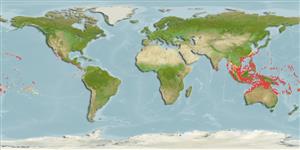Common names from other countries
>
Acanthuriformes (Surgeonfishes) >
Acanthuridae (Surgeonfishes, tangs, unicornfishes) > Acanthurinae
Etymology: Acanthurus: Greek, akantha = thorn + Greek, oura = tail (Ref. 45335).
More on author: Linnaeus.
Environment: milieu / climate zone / depth range / distribution range
Ecologie
marien rifbewoner; diepte 0 - 67 m (Ref. 1602), usually 2 - 67 m (Ref. 27115). Tropical; 21°C - 29°C (Ref. 27115); 30°N - 24°S
Eastern Indian Ocean: known only from Cocos-Keeling Islands and Christmas Island. Pacific Ocean: Ryukyu Islands and Great Barrier Reef to the Hawaiian Islands and French Polynesia (excluding Rapa). This species has crossed the Eastern Pacific Barrier to the Revillagigedo Islands, Cocos Island, Galapagos Islands, and the coast of Mexico.
Grootte / Gewicht / Leeftijd
Maturity: Lm ? range ? - ? cm
Max length : 36.0 cm FL mannelijk / geslacht onbekend; (Ref. 125599); max. gepubliceerd gewicht: 620.00 g (Ref. 125599); max. gerapporteerde leeftijd: 34 Jaren (Ref. 52229)
Dorsale stekels (totaal) : 9; Dorsale zachte stralen (totaal) : 28 - 31; Anale stekels: 3; Anale zachte stralen: 26 - 28. A horizontally elongate white blotch directly below eye. No orange band in outer part of dorsal fin. Caudal peduncle black except for yellow edge of socket and sheath of peduncular spine. Base of pectoral fin black (ref 9808).Gill rakers on anterior row:17-19, on posterior row:18-20.
Adults inhabit hard substrate areas of clear lagoon and seaward reefs from the lower surge zone to at least 67 m and feeds on filamentous algae. Solitary or in groups (Ref. 90102). Monogamous (Ref. 52884, 48637). Benthopelagic (Ref. 58302). Small juveniles shy among large corals (Ref. 48637). Territorial species. Common throughout Micronesia and hybridizes with the rare A. achilles. Size of metamorphosis from the postlarva stage to juvenile is 5.5 to 6 cm (Ref. 9267). Minimum depth reported taken from Ref. 128797.
Levenscyclus en paargedrag
Maturities | Voortplanting | Spawnings | Egg(s) | Fecundities | Larven
Monogamous mating is observed as both facultative and social (Ref. 52884).
Myers, R.F., 1991. Micronesian reef fishes. Second Ed. Coral Graphics, Barrigada, Guam. 298 p. (Ref. 1602)
Status op de Rode Lijst van het IUCN (Ref. 130435)
CITES (Ref. 128078)
Not Evaluated
Gevaar voor de mens
Harmless
Gebruik door de mens
Visserij: visserij voor eigen gebruik; Aquarium: Commercieel
Tools
Speciale rapporten
Download XML
Internetbronnen
Estimates based on models
Preferred temperature (Ref.
115969): 24.5 - 28.8, mean 27.4 (based on 650 cells).
Fylogenetische diversiteitsindex (Ref.
82804): PD
50 = 0.5000 [Uniqueness, from 0.5 = low to 2.0 = high].
Bayesian length-weight: a=0.02630 (0.01489 - 0.04645), b=2.93 (2.78 - 3.08), in cm Total Length, based on LWR estimates for this species & Genus-body shape (Ref.
93245).
Trofisch niveau (Ref.
69278): 2.0 ±0.00 se; based on food items.
Weerstandsvermogen (Ref.
120179): Gemiddeld, minimale populatieverdubbelingstijd 1,4-4,4 jaar (K=0.28; growth and reproduction as expected for Medium; tmax=34 observed only in deep water (RF)).
Fishing Vulnerability (Ref.
59153): Low to moderate vulnerability (30 of 100).
